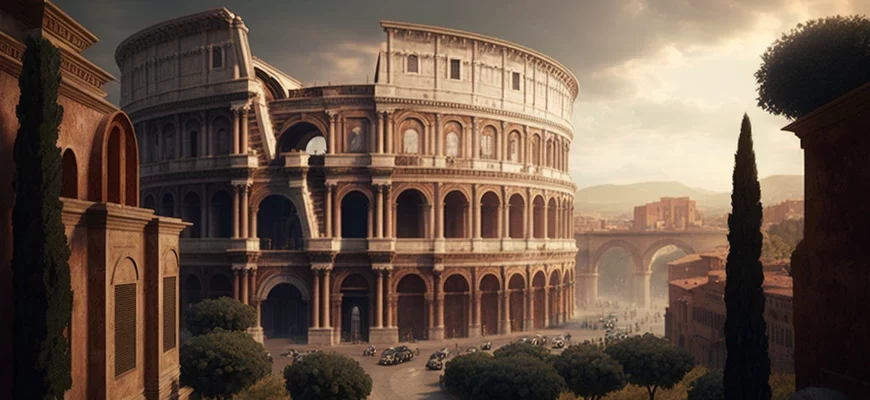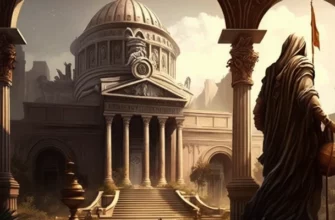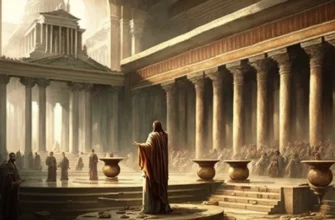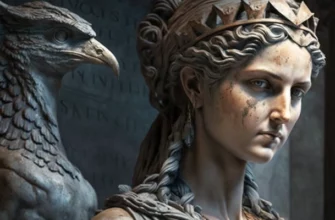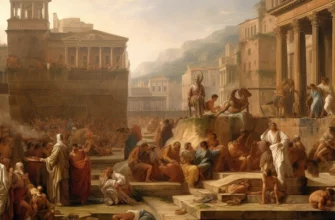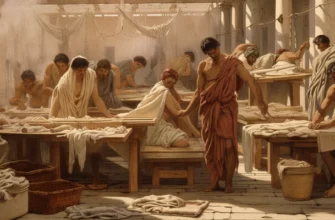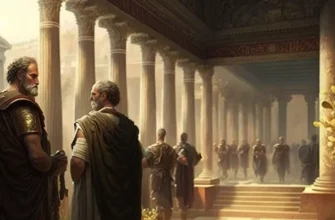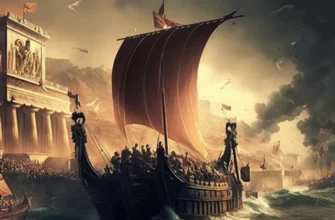Ancient Rome is one of the greatest and most influential civilizations in world history. According to legend, Rome was founded in 753 BC and existed for over 1,000 years. Its history includes the period of the Roman Republic (509-27 BC), when Rome was a republic with an elected government, and the period of the Roman Empire (27 BC-476 AD), when Rome became an empire with autocratic rule. Rome became a symbol of greatness and power, a place where different cultures and civilizations converged. Rome left a significant legacy in culture, art, science, architecture, and military art.
Ancient Rome was founded in 753 BC. The Roman Empire was the largest and most influential state in the world at that time. Rome made a significant contribution to the development of architecture, art, science, and technology. Rome became a symbol of power and strength, a place where different cultures and civilizations converged. Rome left a significant legacy in culture, art, science, architecture, and military art.
- Social and political history
- The creation of the Roman Republic
- The Roman Empire: Rise and Fall
- Rome in the Middle Ages: Decline and Transformation
- Culture and science
- Roman mythology and religion
- Literature and art in the Roman Empire
- Rome’s contribution to science and technology
- Architecture and Engineering
- Construction of the Colosseum and other structures
- Development of roads and other infrastructure
- Roman technology and engineering
- Military history
- The Roman Army and Military Technology
- Rome’s conquests and their consequences
- Conclusion
Social and political history
Ancient Rome began its history as the Roman Republic, which had an elected government and a complex social structure. Over time, the Republic transformed into the Roman Empire, where power passed into the hands of emperors. During this time, there was significant development in culture, art, and science. The fall of the Roman Empire occurred in 476, but Rome left a huge mark on the world, particularly in culture, art, architecture, and law.
The creation of the Roman Republic
Ancient Rome began its history as a small town on the banks of the Tiber in 753 BC. Over time, Rome grew into a large and powerful state.
In 509 BC, Rome became the Roman Republic, where power was elective and divided between two consuls. The republic was divided into social classes – patricians (rich and influential people) and plebeians (poor and ordinary citizens).
During this period, Rome underwent significant development and gained considerable influence in Italy. Roman law and architecture also developed. All this made the Republic one of the most influential and powerful states of its time.
The Roman Empire: Rise and Fall
In 27 BC, the Roman Republic became the Roman Empire when power passed into the hands of the emperors. Octavian Augustus became the first emperor.
Over time, the Roman Empire became the largest and most powerful state in the world, stretching from Europe to Asia and Africa. During this period, there was a significant development of culture, art, and science, in particular, famous writers such as Virgil and Ovid appeared, and architectural masterpieces such as the Colosseum and the Pantheon were built.
However, in the 3rd century AD, the empire began to experience a crisis. Excessive territorial expansion, wars, and financial problems led to the decline of the state. In the 5th century, the empire split into the Eastern and Western Roman Empires, and in 476, the Western Empire was overthrown by barbarians. Nevertheless, the Roman Empire left a huge mark on the world and influenced the formation of European culture, art, and law.
Rome in the Middle Ages: Decline and Transformation
In the Middle Ages, Rome went through difficult periods with a decline in influence and the growing destructive effects of many wars and conflicts. In the Middle Ages, Rome was partially destroyed, but remained an important city for Christianity and the capital of the papacy.
In the 8th century AD, Pope Leo III declared Rome the city of St. Peter and the city of the papacy, opening a new chapter in the city’s history. Rome became the center of religious and cultural life in Europe, and the popes became some of the most influential people in the world.
In the 13th century AD, the popes made a significant contribution to the development of the city, in particular by building the Vatican Palace and many other cultural and religious buildings. In the mid-14th century, Rome experienced a sharp increase in population and the development of urban infrastructure.
However, in the mid-15th century AD, Rome was again destroyed by wars between Florence and Rome. In the following centuries, Rome became the object of conquest by many foreign powers, which brought their cultures and traditions to the city. This led to the formation of the modern face of Rome, which remains one of the most famous cities in the world.
Over the following centuries, Rome became the site of important events in world history, such as the Roman Republic and the Roman Empire. In the early Middle Ages, Rome became the center of the Christian world and an important place of pilgrimage for Christians from all over the world.
In 1870, Rome became the capital of unified Italy, which led to significant modernization of the city and the construction of new industrial and residential areas. Modern Rome is a city with impressive architectural, artistic, and cultural landmarks, such as the Colosseum, the Pantheon, and the Sistine Chapel.
Today, Rome is one of the most important cities in the world, with a high level of cultural and historical significance. The city attracts millions of tourists every year who come to enjoy its beauty and the spirit of times past.
Culture and science
The culture and science of ancient Rome were highly developed. Many schools and universities were founded in the Roman Empire, where art, philosophy, mathematics, and other sciences were taught. The Romans were masters of construction and engineering, building such masterpieces as the Colosseum and aqueducts.
The culture of Ancient Rome included literature, music, theater, and art. The Romans were known for their literature, particularly poetry, epics, and history. Roman theater was a popular art form, and Roman music included instrumental and vocal music.
The culture and science of Ancient Rome had a great influence on the development of culture and science in Western Europe. Much of the knowledge and technology developed by the Romans was preserved and passed on to future generations, forming the basis for further development in various fields of science and culture.
Roman mythology and religion
Roman mythology was a complex system of distorted and borrowed beliefs that combined paganism and the cult practices of other peoples. It included many deities that reflected different aspects of life and nature, such as Jupiter, the god of the sky and thunder, Neptune, the god of the seas and water, and Venus, the goddess of beauty and love.
Roman religion was associated with cult practices and rituals that were accompanied by sacrifices and other rites. These rituals played an important role in the lives of the Romans and were performed in public and at home. Roman deities often reflected the political and social system of Rome, making religion an integral part of Roman life. In the 4th century AD, Emperor Constantine the Great declared Christianity the official religion of the Roman Empire, which determined the further development of religious life in Rome and Western Europe.
Literature and art in the Roman Empire
Literature and art were of great importance in the Roman Empire. Roman literature covered various genres, including epic poetry, comedy, and tragedy. The most famous Roman poets are Virgil, Horace, and Ovid.
Roman art was strongly influenced by Greek culture, but the Romans developed their own styles and techniques. Architecture was one of the most famous art forms, and Roman buildings such as the Colosseum and the Pantheon are still considered architectural masterpieces. Sculpture and painting were also popular art forms in the Roman Empire.
Art and literature were encouraged and funded by the government, wealthy patrons, and the privileged elite, which stimulated the development and prosperity of culture in the Roman Empire.
Rome’s contribution to science and technology
Ancient Rome made a significant contribution to science and technology. The Romans developed and perfected various engineering systems, such as water supply and sewage systems. They also developed architectural solutions that are still used in the modern construction industry.
In the field of science, the Romans made significant contributions to the development of medicine, mathematics, and astronomy. For example, the Roman physician Galen created the first detailed description of the human body and its functions, which was used in medicine for centuries to come.
The Romans also used various techniques and materials to create new inventions, such as manufacturing glass, using artificial lighting, and creating complex mechanisms to perform various tasks.
All these achievements in science and technology played an important role in the development not only of the Roman Empire but also in world history.
Architecture and Engineering
The architecture and engineering of ancient Rome were highly developed. The Romans built huge structures such as the Colosseum, the Pantheon, and the Roman aqueducts. They used complex engineering systems to provide for the city’s vital needs, such as water supply and sewage. Many of these engineering systems functioned for centuries and were improved over time.
Roman architecture featured many innovative solutions, such as the use of domes, which provided structural stability and increased space. The Romans also used complex technologies to create concrete and process stone.
The Romans made a significant contribution to engineering by developing water supply and sewage systems that are still in use in many cities around the world. Roman aqueducts consisted of stone arches and channels that carried water to the city from large sources tens of kilometers away.
All these Roman innovations and technologies became the basis for the further development of architecture and engineering in Europe and around the world.
Construction of the Colosseum and other structures
The construction of the Colosseum is one of the most famous achievements of Roman architecture, but Rome is famous for other great structures such as the Pantheon, the Roman Forum, the Baths of Caracalla, and the Baths of Diocletian. These structures reflect the high level of engineering knowledge and technical achievements of the Roman Empire. Rome also developed a water supply system that included large aqueducts and water towers that provided water for the city and its inhabitants.
Development of roads and other infrastructure
The Roman Empire was famous for its road system, which included more than 400,000 km of roads. The main roads were the Appian Way and the Flavian Way, which connected Rome with all parts of the empire. Rome also had a large number of other infrastructure facilities, such as aqueducts, theaters, amphitheaters, forts, and bridges. These facilities not only provided convenient transportation, but also contributed to the development of culture and sports. Many of them have survived to this day and are popular tourist attractions.
Roman technology and engineering
Roman technology and engineering were highly developed and ensured the success of the Roman Empire. The Romans were skilled at building complex engineering structures such as aqueducts and tunnels using sophisticated mechanisms and materials such as concrete. They were also skilled in drainage and ventilation in buildings. Roman engineers also developed new tools and inventions that were used to construct buildings and roads. All of these technologies and engineering solutions helped the Roman Empire become one of the most influential and prosperous civilizations in the world.
Military history
The military history of Ancient Rome was well organized. The Roman army was one of the strongest in the world and helped Rome expand into most of Western Europe, the Mediterranean, and the Middle East. The Roman legions were disciplined, highly organized, and well armed. They used various strategies, such as forming circles and blockading the enemy. Rome’s military success was also ensured by innovations in weapons, such as catapults and ballistas, which helped destroy enemy defensive walls. Thus, the Roman Empire became the largest and most powerful state in the world, thanks to its military might and ingenuity.
The Roman Army and Military Technology
The Roman army was one of the most disciplined and effective in history, capable of defeating more numerous enemies thanks to its military technology and tactics. Military technology included a variety of sophisticated weapons, military machines, and equipment such as catapults, cannons, and ballistas. The Roman army expanded and controlled territories from Britain to Palestine. Throughout its history, the Roman Empire faced various enemies, including the Carthaginian state, the Gauls, the Greeks, and the Parthians.
Rome’s conquests and their consequences
Rome’s conquests laid the foundation for its imperial prosperity, brought significant profits and resources, and ensured the expansion of its power and territories. However, they also led to the destruction of numerous cultures and civilizations, as well as the decline of the Roman Republic, which was caused by difficulties in managing the acquired territories and socio-economic problems. Over time, the conquered territories ceased to bring benefits and became the cause of a crisis in the empire. The need to protect borders and the growth of military spending led to complex economic difficulties and the decline of the empire.
Conclusion
Ancient Rome is of great importance to world history. Rome was one of the most influential centers of culture, power, economy, and politics in the world for many centuries. The Roman Empire emerged in the 3rd century BC and continued to exist until the 5th century AD. During this period, Rome became one of the largest and most powerful states in the world.
Roman culture has influenced all areas of modern life, including art, architecture, literature, law, and religion. The ideas and values that took shape in Rome continue to influence modern society, particularly European culture and its values.
Rome is also known for its technological achievements, such as roads, drainage systems, and engineering structures, which have influenced the development of infrastructure around the world.
The political system of Rome, in particular Roman republicanism and the ideas of Roman law, became important factors in the formation of democratic institutions around the world.
Thus, Ancient Rome is of great importance to world history and continues to influence the modern world in many aspects of our lives.
